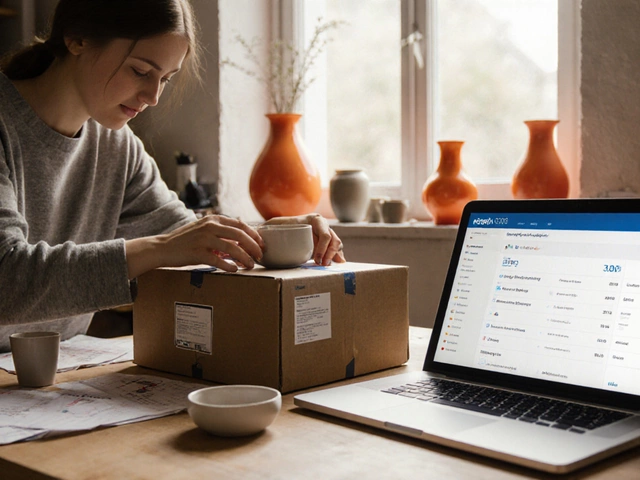Ever wondered how e-commerce differs from dropshipping, especially when it comes to logistics? Well, you're not alone! Both sound pretty similar, right? You sell stuff online, ship it to customers, and bam, you're in business. But here's where it gets interesting: the logistics involved are quite different.
In a typical e-commerce setup, you manage your inventory. This means you buy products upfront, store them in a warehouse or your garage, and handle the shipping yourself. It gives you more control over quality and stock levels, but it also comes with the risk of unsold inventory.
On the flip side, dropshipping takes a different route. It's like being the middleman. You don’t keep the products you sell in stock. Instead, when a customer buys an item from your store, you order it from a third-party supplier who ships it directly to the customer. This means no stacks of products cluttering your space, but it also means relying heavily on your suppliers' stock and shipping speed.
- Defining E-commerce and Dropshipping
- Inventory Management Differences
- Shipping and Fulfillment Processes
- Pros and Cons of Dropshipping
- When to Choose E-commerce
- Choosing the Right Model for Your Business
Defining E-commerce and Dropshipping
Let's break it down right here: e-commerce is the big umbrella term for any buying and selling done online. If you're selling handmade pottery on your website or through a platform like Etsy, you're in the e-commerce game. You get the goods, manage inventory, set up your online store, and ship products straight to your customers. It's the classic online business model where you know every detail about your products because you handle them yourself.
Now, dropshipping is a bit of a twist on this. It's still within the e-commerce realm, but it shakes things up by cutting out the need for inventory. Imagine having an online store without having to stockpile or store anything. Instead, when someone orders from your site, you purchase the item from a third-party supplier who ships it directly to your customer. You serve as the middleman, often working closely with suppliers based in other regions, maybe even continents.
Here's where it gets interesting. Both models have their perks and challenges. Traditional e-commerce gives you control over what's in stock and how quickly it gets to customers, which can mean better customer service. But you're also on the hook if the inventory doesn't sell. On the flip side, dropshipping allows flexibility and lowers upfront costs, but it can lead to complications if the supplier is out of stock or slow at shipping.
| Aspect | E-commerce | Dropshipping |
|---|---|---|
| Inventory | Managed by seller | Managed by supplier |
| Upfront Costs | Higher | Lower |
| Control Over Stock | High | Low |
| Shipping | Seller ships | Supplier ships |
Inventory Management Differences
When it comes to inventory management, e-commerce and dropshipping are like night and day. Each approach has its own rhythm, pros, and quirks.
E-commerce Inventory
In the traditional e-commerce model, you're in charge of purchasing, storing, and managing products. This means deciding on suppliers, paying for inventory upfront, and finding a place to store it all. People often use warehouses or self-storage units. Got a spare room? It might just become your product haven!
This approach lets you personally inspect your products, ensuring quality and consistency. It also means you can offer fast shipping since everything is on hand. However, it's a bit of a gamble. You'll need to carefully analyze market trends to avoid ending up with unsold stock that collects dust.
Dropshipping Inventory
On the flipside, dropshipping skips this hassle. You list products on your site, but they're actually stored by your supplier. When someone makes a purchase, the supplier takes over: they pack and ship the item straight to the customer. Holy simplicity, right?
This method saves up on storage costs and time. Plus, there's less financial risk since you only pay for what you sell. Yet, you do sacrifice some control. You might face issues if the supplier runs out of stock unexpectedly or doesn't meet quality standards. Worse case: customer dissatisfaction.
Inventory Challenges and Decisions
Both models have their inventory challenges and decisions to make. For e-commerce, it's about managing warehouse operations, often needing software to track what's in and out. Meanwhile, in dropshipping, your job is more about maintaining good supplier relationships and keeping a varied, appealing product range.
Choosing between these methods ultimately depends on your business goals. Want hands-on control and faster shipping? E-commerce might be your game. Prefer a low-risk start with lower overhead? Then dropshipping could be the way to go.
Shipping and Fulfillment Processes
Okay, let’s dive into what really sets e-commerce apart from dropshipping in terms of getting those products to your customers. Spoiler alert: they handle this core part of the business quite differently!
E-commerce Shipping Dynamics
In the world of traditional e-commerce, it's all about control. You're essentially the boss of your own shipping pipeline. Most e-commerce sellers will have a dedicated space or a third-party service to handle inventory. It means you pack and ship orders yourself or have a fulfillment center do it for you. A neat tip? Network with multiple shipping carriers to get better rates and faster deliveries.
Dropshipping Logistics Made Simple
Things are a bit different with dropshipping. You never actually see or touch the products you're selling. Once a customer places an order, it shoots straight to your supplier, who then ships it directly to the customer. Simple, right?
This can save you from dealing with the nitty-gritty of packing tape and shipping labels. However, it also means less control over shipping times or packaging quality. A practical tip for dropshippers is to partner with reliable suppliers and constantly communicate to ensure the best shipping experience for your customers.
Quick Comparison Table
| Aspect | E-commerce | Dropshipping |
|---|---|---|
| Inventory | In-hand or third party | Suppliers handle |
| Shipping Control | Full control | Third parties handle |
| Initial Cost | Usually higher due to stock | Low start, pay-as-you-go |
Each method has its pros and cons. While e-commerce gives you more control, it requires more upfront investment. On the flipside, dropshipping is less hands-on but your customer experience is in the hands of your suppliers. Stick to what matches your business ambitions and resources best!

Pros and Cons of Dropshipping
If you're diving into the world of online selling, dropshipping might have caught your eye. It's got its perks, but it's not all sunshine and rainbows. Let's break down the pros and cons of this dropshipping model, especially in terms of e-commerce logistics.
Pros of Dropshipping
1. Low Starting Costs: You don't need to invest loads of cash in inventory. Without the headache of buying and storing products upfront, you can start your online e-commerce business on a tight budget.
2. Easy to Scale: With dropshipping, scaling is a breeze. Since you’re not tied to any inventory, you can easily test new products or enter different markets.
3. Wide Product Selection: The world is your oyster when it comes to products. You can offer a huge variety without worrying about stockroom space.
4. Focus on Marketing: Since the logistics are handled by suppliers, you can channel your energy and time into marketing and customer engagement.
Cons of Dropshipping
1. Lower Profit Margins: No inventory might mean less initial investment, but it often comes at the cost of thinner profit margins. Suppliers get their cut, which leaves you with less.
2. Dependency on Suppliers: Your reputation is tied to your suppliers. If they mess up with shipping or quality, it can turn into a customer service nightmare for you.
3. Fierce Competition: Since dropshipping is easy to start, competition is intense. You need to find ways to stand out in a crowded online marketplace.
4. Inventory Issues: You're not in control of the stock, which means products can be advertised as available but are actually out of stock. This could lead to customer frustration and lost sales.
While dropshipping might seem like an easy path with its low barrier to entry, consider these factors before jumping in. It’s crucial to weigh these pros and cons against your own business goals and resources.
When to Choose E-commerce
Let's get down to brass tacks. When should you go the e-commerce route instead of dropshipping? Well, if you’re all about having control over your products and building a distinctive brand, that's a big clue. Owning inventory means you personally handle everything from quality control to delivery, allowing you to create a personalized customer experience.
Another scenario you might want to consider is if you're planning to sell unique or custom products. Think about it: when you have a niche product that customers can't just find anywhere else, managing your own stock becomes essential. This way, you can better handle any special requirements or customizations that your customers might want.
Ensuring Better Profit Margins
Managing your own e-commerce store could also be the way to go if larger profit margins are your goal. Since you buy the products in bulk directly from manufacturers, you often get them at a lower cost than if you bought individual items for dropshipping. More control equals more savings, which typically means you can offer competitive prices while still making a decent profit.
Scalability and Long-term Growth
Finally, if you're eyeing the long game, e-commerce gives you the scalability you'll eventually need. By handling your own logistics, you’re better positioned to expand into new markets or add more products to your line without relying on third-party suppliers. It can be more work upfront, but it pays off in the long run if growth is your ultimate goal.
So, to wrap it up: if you value control, have a unique product, are targeting higher profit margins, or are aiming for significant growth, e-commerce might just be your best bet. But remember, each path has its own perks, so weigh your priorities and choose wisely.
Choosing the Right Model for Your Business
Deciding between the classic e-commerce model and dropshipping isn't just about logistics; it's about what fits your business vision and resources. Let's break it down to help you choose what's best for you.
Assess Your Resources
First, take stock of your resources. If you have enough capital to purchase inventory and a place to store it, then traditional e-commerce could be your jam. But, if you're tight on budget and space, dropshipping offers a low-entry point with no need for holding stock.
Control Over Products
Do you want to have control over what you sell and how quickly you can ship? With e-commerce, you're the boss of your stock, meaning you can often ship faster and ensure product quality. In dropshipping, since you're relying on suppliers, you have less control over these elements. Think about how much control you want or need.
Risk Management
This is a big one. E-commerce ventures often deal with unsold inventory risk. You might end up with products that just don't move. Dropshipping, however, mainly struggles with out-of-stock issues from suppliers, which could lead to delays. Analyze which risks you're more comfortable handling.
Time Commitment
E-commerce can be time-consuming with inventory management and shipping tasks. If you prefer spending more time on marketing rather than logistics, dropshipping might better suit you. It allows for a leaner operation focused on driving sales.
Profit Margins
Finally, let's talk money. Traditional e-commerce generally offers better margins since you buy in bulk. Dropshipping often involves lower margins because your cost per item is higher. Weigh which is more important to your business: higher volume or higher margins.
Still Deciding?
If the choice isn’t clear cut, consider a hybrid model. Some businesses blend both e-commerce and dropshipping. For example, you could hold stock of your best-sellers and dropship the less popular items.
| Aspect | E-commerce | Dropshipping |
|---|---|---|
| Initial Investment | High | Low |
| Control Over Stock | High | Low |
| Risk Type | Unsold Inventory | Out-of-Stock |
| Profit Margins | Higher | Lower |
Choosing the right model is all about matching with your business goals, strengths, and limitations. Whatever path you choose, make sure it aligns with how you want to run your business day in and day out!





